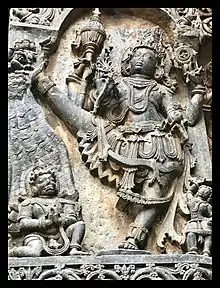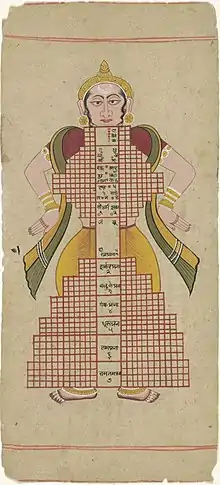Trailokya
Trailokya (Sanskrit: त्रैलोक्य; Kannada: ತ್ರೈಲೋಕ್ಯ; Pali: tiloka, Tibetan: khams gsum; Chinese: 三界; Vietnamese: Tam Giới) literally means "three worlds"[1][2][3][4][5] It can also refer to "three spheres,"[3] "three planes of existence,"[6] "three realms"[6] and "three regions."[4]

Sculpture of Vamana, an avatar of Vishnu, who is associated with the legend of taking three strides upon the three worlds
Conceptions of three worlds (tri-loka) appear in Hinduism and Jainism, as well as early Buddhist texts.

The Triloka Purusha, the figure who embodies the three worlds.

Transcending the Three Realms 超出三界圖, 1615 Xingming guizhi
Hindu cosmology
| Part of a series on |
| Hinduism |
|---|
 |
The concept of three worlds has a number of different interpretations in Hindu cosmology.
- Traditionally, the three worlds refer to either the earth (Bhuloka), heaven (Svarga), and hell (Naraka),[7] or the earth (Bhuloka), heaven (Svarga), and the netherworld (Patala)[8]
- The Brahmanda Purana conceives them to be Bhūta (past), Bhavya (future), and Bhavat (present)[9]
- In Vaishnavism, the three worlds are often described to be bhūr, bhuvaḥ, and svaḥ (the gross region, the subtle region, and the celestial region)[10]
- In the Nilanamatapurana, Vamana covers his second step on the three worlds of Maharloka, Janaloka, and Tapoloka, all of which are regarded to be a part of the seven heavens[11]
Buddhist cosmology
In Buddhism, the three worlds refer to the following destinations for karmic rebirth:
- Kāmaloka the world of desire, typified by base desires, populated by hell beings, preta (hungry ghosts), animals, humans and lower demi-gods.
- Rūpaloka is the world of form, predominantly free of baser desires, populated by dhyāna-dwelling gods, possible rebirth destination for those well practiced in dhyāna.
- Arūpaloka is the world of formlessness, a noncorporeal realm populated with four heavens, possible rebirth destination for practitioners of the four formlessness stages.[3]
See also
Notes
- Monier-Williams (1899), p. 460, col. 1, entry for "[Tri-]loka" (retrieved at http://www.sanskrit-lexicon.uni-koeln.de/scans/MWScan/MWScanpdf/mw0460-trimala.pdf) and p. 462, col. 2, entry for "Trailoya" (retrieved at http://www.sanskrit-lexicon.uni-koeln.de/scans/MWScan/MWScanpdf/mw0462-tripu.pdf).
- Rhys Davids & Stede (1921-25), p. 301, entry for "Ti-" (retrieved at http://dsal.uchicago.edu/cgi-bin/philologic/getobject.pl?p.1:129.pali). Here, tiloka is compared with tebhūmaka ("three planes").
- Fischer-Schreiber et al. (1991), p. 230, entry for "Triloka." Here, synonyms for triloka include trailokya and traidhātuka.
- Blavatsky (1892), pp. 336-7, entry for "Trailokya" (retrieved at http://www.phx-ult-lodge.org/ATUVWXYZ.htm#t).
- Purucker (1999), entry for "Trailokya" (retrieved at http://www.theosociety.org/pasadena/etgloss/tho-tre.htm).
- Berzin (2008) renders khams-gsum (Wylie; Tibetan) and tridhatu (Sanskrit) as "three planes of existence" and states that it is "[s]ometimes called 'the three realms.'" Tridhatu is a synonym of triloka where dhatu may be rendered as "dimension" or "realm" and loka as "world" or even "planet."
- www.wisdomlib.org (2017-11-18). "Trailokya: 19 definitions". www.wisdomlib.org. Retrieved 2022-08-18.
- Maruvada, Surya N. (2020-03-02). Who is Who in Hindu Mythology - VOL 2: A Comprehensive Collection of Stories from the Pur??as. Notion Press. ISBN 978-1-64805-686-4.
- www.wisdomlib.org (2019-06-20). "Vaivasvata Manvantara: the Mārīca creation [Chapter 38]". www.wisdomlib.org. Retrieved 2022-08-18.
- www.wisdomlib.org (2008-09-27). "Triloka, Tri-loka: 12 definitions". www.wisdomlib.org. Retrieved 2022-08-18.
- www.wisdomlib.org (2019-01-28). "Story of Vāmana". www.wisdomlib.org. Retrieved 2022-08-18.
Sources
- Berzin, Alexander (March 6, 2008). Berzin Archives Glossary. Retrieved Sunday July 13, 2008 from "Berzin Archives" at http://www.berzinarchives.com/web/en/about/glossary/glossary_tibetan.html.
- Blavatsky, H.P. (1892). Theosophical Glossary. London: Theosophical Publishing Society. Retrieved 2008-07-14 from "The Theosophical Glossary (United Lodge of Theosophists, Phoenix, Arizona)" at http://theosophicalglossary.net/.
- Fischer-Schreiber, Ingrid, Franz-Karl Ehrhard, Michael S. Diener and Michael H. Kohn (trans.) (1991). The Shambhala Dictionary of Buddhism and Zen. Boston: Shambhala Publications. ISBN 0-87773-520-4.
- Monier-Williams, Monier (1899, 1964). A Sanskrit-English Dictionary. London: Oxford University Press. ISBN 0-19-864308-X. Retrieved 2008-07-13 from "Cologne University" at http://www.sanskrit-lexicon.uni-koeln.de/scans/MWScan/index.php?sfx=pdf.
- Purucker, G. de (ed.-in-chief) (1999). Encyclopedic Theosophical Glossary: A Resource on Theosophy. Theosophical University Press. Retrieved from "The Theosophical Society" at http://www.theosociety.org/pasadena/etgloss/etg-hp.htm.
- Rhys Davids, T.W. & William Stede (eds.) (1921-5). The Pali Text Society’s Pali–English Dictionary. Chipstead: Pali Text Society. Retrieved 2008-07-13 from "U. Chicago" at http://dsal.uchicago.edu/dictionaries/pali/.
- W. E. Soothill & L. Hodous (1937-2000). A Dictionary of Chinese Buddhist Terms. Delhi: Motilal Banarsidass. ISBN 81-208-0319-1.
External links
- Bullitt, John T. (2005). The Thirty-one Planes of Existence. Retrieved 2007-04-30 from "Access to Insight" at http://www.accesstoinsight.org/ptf/dhamma/sagga/loka.html.
- 31 Planes of Existence by Bhante Acara Suvanno
- 31 Planes of Existence - chart
This article is issued from Wikipedia. The text is licensed under Creative Commons - Attribution - Sharealike. Additional terms may apply for the media files.